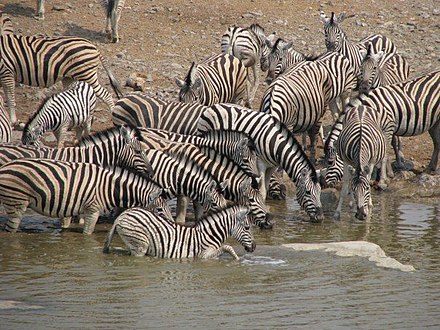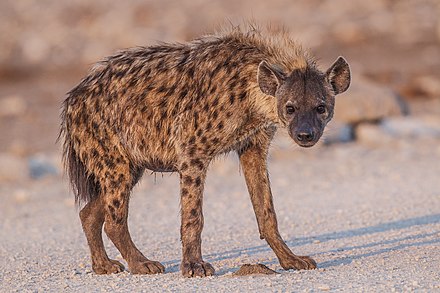Etosha National Park - national park of Namibia
 Etosha National Park (dead link: January 2023) is the second largest of Namibia's game reserves (after Namib-Naukluft National Park). It spans 20,000 km² in the Four-O region. The park surrounds the dry Etosha salt pan. The waterholes surrounding the pan attract animals, particularly in the drier winter months, because it is a source of water in a very dry land.
Etosha National Park (dead link: January 2023) is the second largest of Namibia's game reserves (after Namib-Naukluft National Park). It spans 20,000 km² in the Four-O region. The park surrounds the dry Etosha salt pan. The waterholes surrounding the pan attract animals, particularly in the drier winter months, because it is a source of water in a very dry land.
Understand
Its name means "big white place", referring to the Etosha Salt Pan.
All facilities inside the park are run by Namibia Wildlife Resorts, a company owned by the Namibian Government.
History
The park is over a hundred years old. And one of the most famous in the world.
Landscape
The park surrounds the Etosha salt pan an arid and dusty area - which is entirely dry for most of the year - it may only fill with water on one or two occasions throughout the year. The waterholes and boreholes that surround the pan attract a great deal of wildlife during the dryer months - as the only source of water in this harsh landscape.
Flora and fauna
There is lots of wildlife here that is easy to see. Springbok, Black-faced Impala, Zebra, Giraffe, Warthog, and Wildebeest will be hard to miss even driving along the main roads.
Elephant and Rhino are often seen in the bush and waterholes. There are a healthy populations of cheetah, lion and leopard for those with a keener eye on the shadows.
There are around 100 other species of mammals in the park. Jackals, hyena, dik-dik, steinbok, to name but a few.
There are no buffalo in the park, as there is simply insufficient water to sustain them.
Climate
Get in
The options are to take your own vehicle (hire or owned), to join a tour, or to fly on a charter.
Visitors are not permitted to walk in the park outside of a vehicle (except in the enclosed camping/hotel areas) on foot. Although it is possible to fly to one of the camps or lodges and take day-safari trips from the lodge.
If you are driving, the B1 from either Oshakati or Tsumeb) brings you to the park's eastern gate at Namutoni. The C38, from Outjo bring you to the park's southern gate.
Safari companies operate from Windhoek and Swakopmund and offer tours of varying length in Etosha. Old maps might show the western part of the park as 'closed for private travellers' but this is no longer true.
Fees and permits
Entry fees are $80 per person per day, and $10 per vehicle per day.
The process to enter is bureaucratic. You fill in the paperwork at the gate, fill in your entry details, and then take it to an administration office at the camp to pay. You can buy multi-day tickets as long as they are for consecutive days. You can expect this process to take up to an hour during the busy season by the time you wait at the gate and again queue at the administration office. Credit cards and cash are accepted. You will need to show this paperwork each time you enter and exit the park.
Get around

Be careful when driving on gravel roads especially when braking as there is very little traction available and one can skid very easily. There is fuel available in the camps and at just outside the park gates. All the fuel stations accept credit and debit cards.
See





- Animals! Throughout the park, particularly at watering holes, of which there are many.
- Rest Camp watering holes At all three rest camps, there is are watering holes just outside the perimeter fence. At night they are lit with flood lights and visitors can sit and watch as the animals come down to drink, flirt and occasionally fight well into the night. They are ideal places to wander down to with a sundowner after getting back from a days game spotting. Visitors are not allowed out of the rest camps after sunset so the waterholes provide the opportunity to continue watching the animals after dark.
Do
What else to do then see the wildlife! From every hotel there are possibilities to do a game drive, be sure to bring your binoculars as some animals (like lions or cheetahs) can only be watched when distance is kept. Also when close to animals be very quiet, most animals will be scared by the slightest noise.
The best time to easily see a lot of wildlife is in the afternoon around 15:30, be aware that the gates are closed to the park and to the camps at sunset. During the dry season the waterholes viewed from each of the camps offer good wildlife viewing. Wildlife tend not to come to the waterholes during the wet.
Buy
A good map that has all the water holes that tells you where to see the animals you may want to see. You can also download from the parks site before you travel.
Eat
Food is available at restaurants and kiosks in the camps. However, stocks are limited, and it's a monopoly provider. So you won't starve, but you will be paying a little over the odds for below par food. Also the opening hours are around mealtimes, so if you get into camp mid-afternoon hoping for some lunch you may be out of luck.
Drink
Sleep
There are five designated rest camps for visitors, enclosed by walls and fences. Namutoni, Halali and Okaukejo have camping, and most offer petrol stations, pools and shops for those things you forgot. The gates for camps open at sunrise and close at sunset. You are not allowed outside of a camp during night. Bush camping is not permitted. All lodges and campsites inside of the park can be booked through Namibia Wildlife Resorts.
There is other accommodation available near the park gates. This is often superior in quality and better value. You can take game drives into the park - but you should factor in the time taken to enter the park.
Onguma is a separate area to the east of the park, offering accommodation and wildlife of its own.
- Namutoni. This is on the site of an old German fort which was burned down many years ago in a raid by the Ovambo people from the north. Today the fort is a hotel. There is also a shop where you can buy food and basic supplies and a restaurant and bar. There is a small museum here. Nice camp to walk around and watch the mongoose.
- Halali. This has the most impressive floodlit water hole with a viewing platform - you can walk down after setting up camp and sit here at sunset, drink a sundowner and watch the animals come down to drink. Being away from the edges of the park, this camp is at its busiest during the lunchtime rush. It probably the least attractive of the camps, with the most basic accommodation, but it has the largest pool.
- Okaukuejo. There are small huts available, as well as a restaurant and pool. Be sure to have a look at the waterhole around midnight, you can often see rhinos even during wet season. This has the best layout among all the camps and the best waterhole for sitting down and watching animals. The camp itself is attractive, and the accommodation is pleasant.
- Dolomite Camp. It is a camp that is fairly new and offers luxury accommodation full board. The camp is situated on the top of a Koppie.
- Onkoshi. This camp is located on the edge of the Etosha pan and features fifteen huts built on elevated wooden decks.
Stay safe

At night, jackals may walk around your campsite, they will usually flee when they see you but be careful, some jackals carry rabies.
Although all campsites are fenced, do not sleep outside, especially not on the benches surrounding the waterholes. The fence is not high there and not really an obstacle for a lion.
Etosha is in a low-risk malaria zone. You should take medical advice before you travel and appropriate precautions.
Go next
Northeast of Etosha the Caprivi Strip offers more game parks and is en route to the Victoria Falls. On the way is the town of Tsumeb, where you can stop to visit the Tsumeb Museum, home of interesting mineral specimens such as dioptase from the local Tsumeb Mine, as well as the Helvi Mpingana Kondombolo Cultural Village for exhibits on various Namibian villages and ways of life. Two unique features about Tsumeb are that in the surrounding area are three sinkholes with uncharted depths due to subterranean laterite cave systems at the bottom, and secondly that the presence of the largest meteorite in the world, Hoba, weighing in at about 60 tons, is located in a site developed for tourism about 40 minutes southeast of the town.
You could stock up and stay overnight here, too, since it's a long way across the Central Plateau.
Related: African National Parks
Related: African flora and fauna